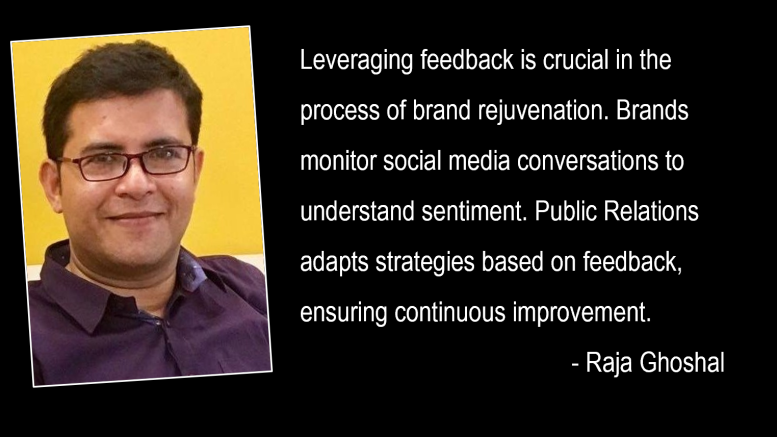As the saying goes, everything remains the same yet nothing lasts forever. It aptly applies to brands as well. A mighty brand of yore often bites the dust with the passage of time. Unless of course the brand is rejuvenated from time to time and kept fit as a fiddle!
In effect, brand rejuvenation is a strategic process that revitalises an established brand, ensuring it remains relevant, resonates with its audience, and adapts to changing market dynamics. Public Relations (PR) and strategic communications plays a pivotal role in this process, helping brands re-invent themselves and thrive.
Brand rejuvenation goes beyond superficial changes like logo re-designs or colour updates. It involves a holistic transformation that encompasses strategic re-positioning wherein a brand re-evaluates its core values, mission, and vision to align with evolving consumer needs and market trends.
Having said that, in terms of visuals, a refreshed logo, packaging, and design elements contributes its fair share to the brand’s new identity. In fact, visual as well as messaging consistency across platforms is critical for the brand’s rejuvenated identity.
Narrative refinement is a key essence of brand rejuvenation. PR helps craft compelling stories that resonate with the audience, emphasising the brand’s purpose and uniqueness.
Broadly speaking, there are two types of rebranding – proactive rebranding and re-active rebranding. In the former, organisations proactively seek growth opportunities, innovation, or new customer segments. For Example: Titan Industries transformed into Titan Company, emphasising global standards and innovation. Read More
In reactive re-branding, the re-imagining of the brand essentially happens as part of a reaction to an event or phenomenon often triggered by external factors like market shifts, mergers, or acquisitions. For Example, Hutch rebranded to Vodafone after a merger, maintaining continuity while adapting to change.
Successful Indian rebranding case studies may include State Bank of India (SBI) wherein it revamped its image by adopting a modern logo and positioning itself as a progressive bank, which arguably resulted in increased customer trust and appeal.
Britannia shifted from a traditional biscuit brand to a health-conscious one. PR campaigns highlighted their healthier product range. Result: Enhanced brand perception and market share. Bajaj transformed from a scooter-focused brand to a global motorcycle brand powerhouse. PR emphasised innovation, performance, and global aspirations. Result: Expanded market presence. McDonald’s India localised its menu, emphasising vegetarian options. PR campaigns highlighted community engagement and sustainability. Result: Strengthened brand affinity.
Globally, Apple’s rebranding journey is iconic. It evolved from a computer company to a lifestyle brand. PR focused on innovation, simplicity, and user experience. Result: Apple became synonymous with cutting-edge technology. Aditya Birla Group repositioned itself as a global conglomerate. PR highlighted its diverse portfolio, sustainability initiatives, and community impact. Result: Enhanced global recognition.
Advertising, PR, Corporate Communications, Marketing Collaterals and events all play their part in the brand rejuvenation process. However, a stellar role in brand rejuvenation is increasingly being played by the ubiquitous Social Media. This is primarily done through audience Engagement. Social media is effectively leveraged to highlight brand values, achievements, and behind-the-scenes glimpses.
Social media allows brands to directly connect with their audience, fostering meaningful interactions. Brands can respond to queries, address concerns, and showcase their personality. Example: Wendy’s witty Twitter responses garnered attention and transformed its brand image. During crises, social media allows brands to address issues transparently. PR teams can manage reputation by promptly sharing accurate information. Another approach for social media is Storytelling and Content Creation – Brands share compelling narratives through posts, videos, and stories.
Brands also partner with Influencers to amplify their rejuvenation efforts. Influencers authentically endorse products, reaching niche audiences. Example: Fenty Beauty’s collaboration with Rihanna leveraged her influence to redefine beauty standards.
Leveraging feedback is crucial in the process of brand rejuvenation. Brands monitor social media conversations to understand sentiment. PR adapts strategies based on feedback, ensuring continuous improvement. For Example: Starbucks revamped its loyalty program based on customer feedback shared on social media.
In essence, effective PR drives brand rejuvenation by shaping perceptions, fostering meaningful conversations, and aligning brands with their audiences. As businesses evolve, PR remains a powerful tool to ensure that brands not only survive but thrive in a dynamic marketplace. Remember, with strategic PR, a brand can transition from being merely appreciated to a truly admired one!
The views and opinions published here belong to the author and do not necessarily reflect the views and opinions of the publisher.



Be the first to comment on "Brand Rejuvenation: The Role of PR and Strategic Communications in keeping brands healthy"